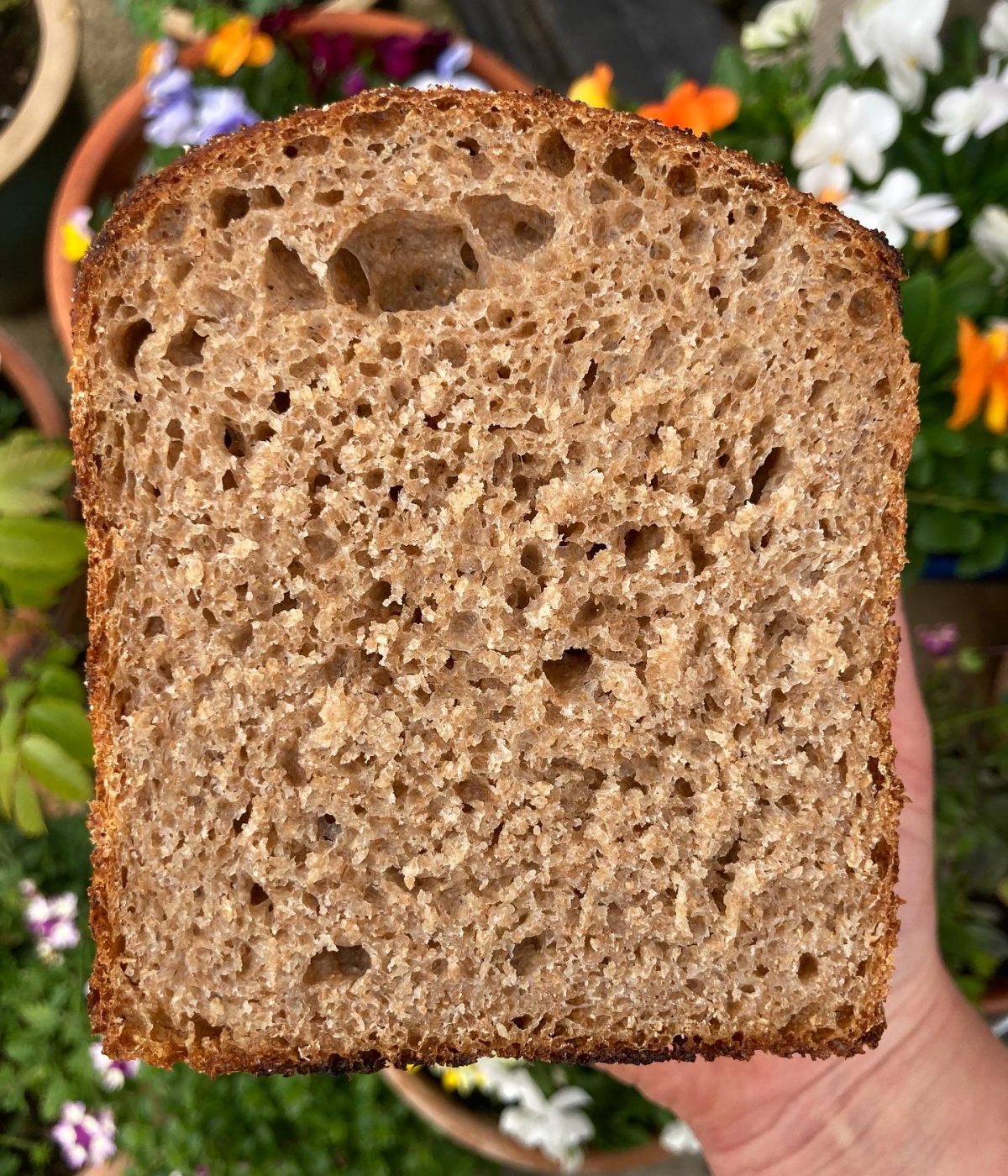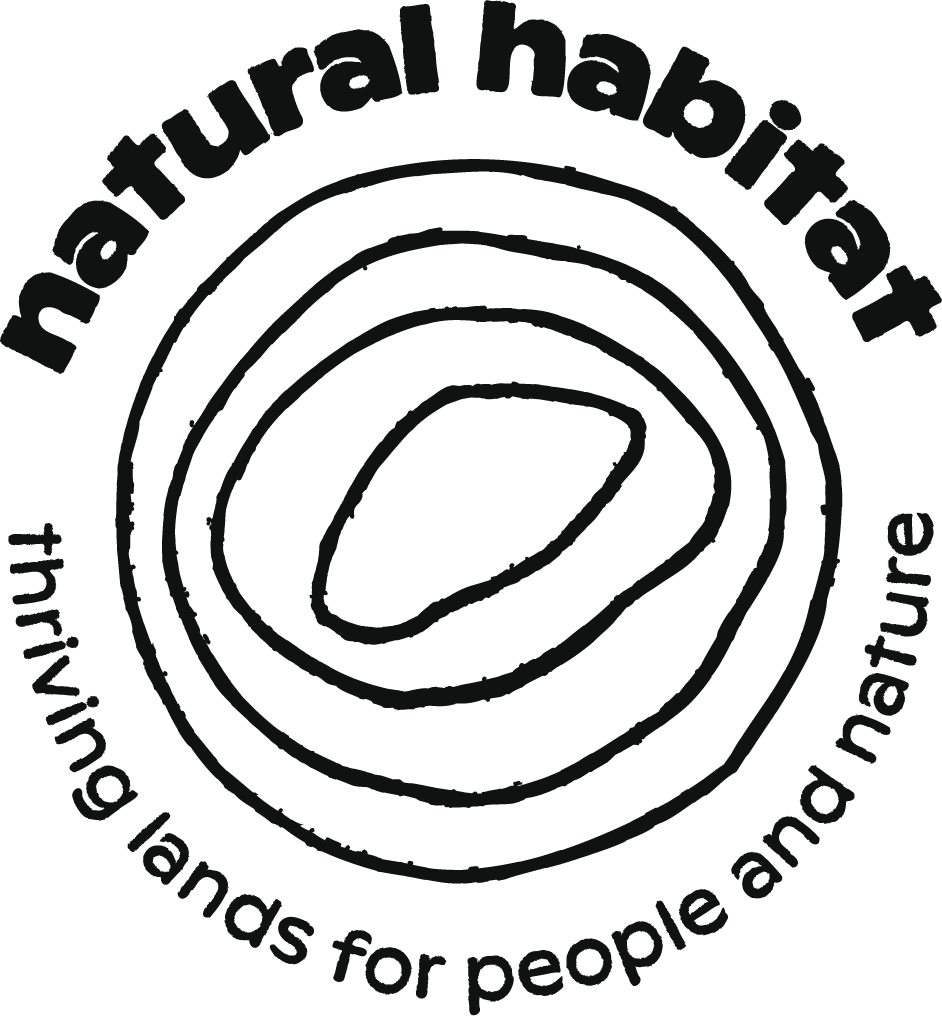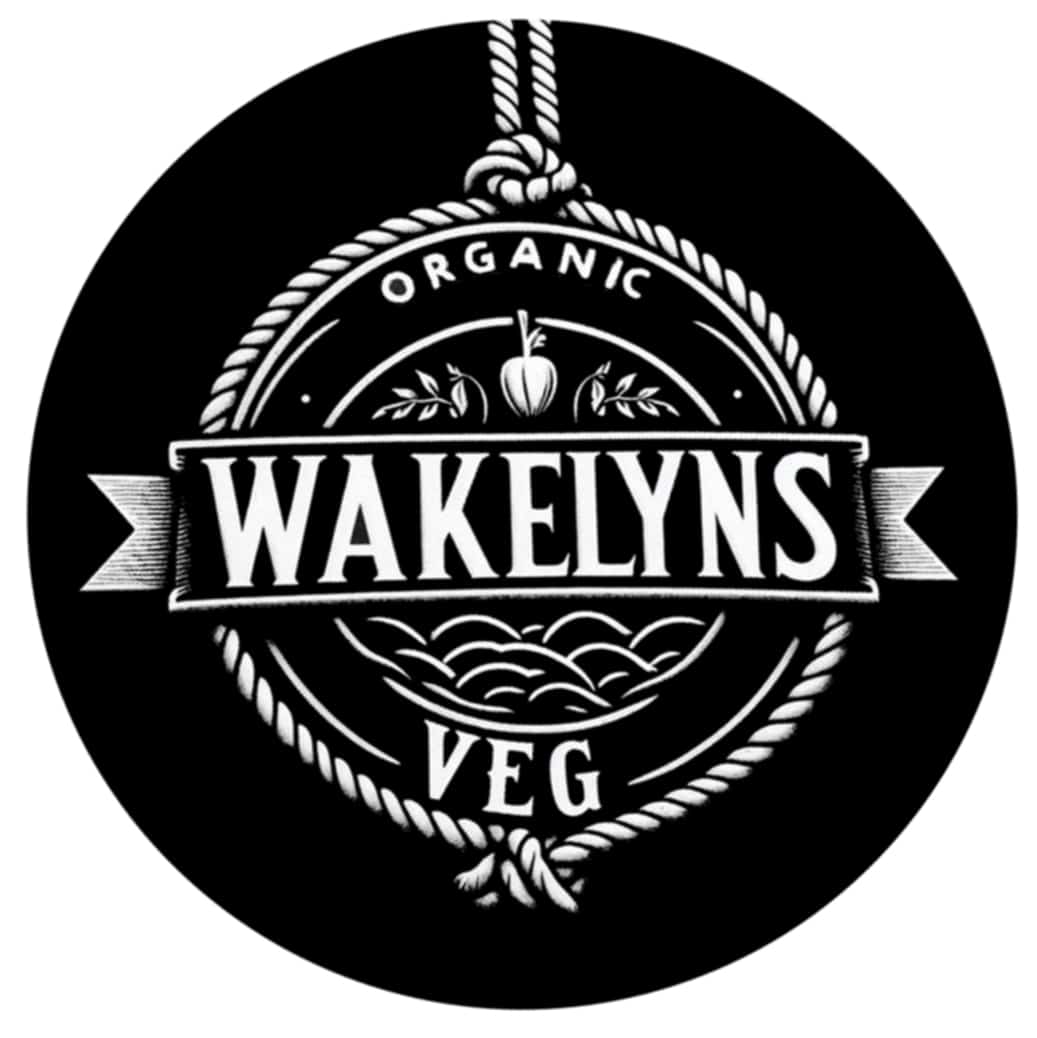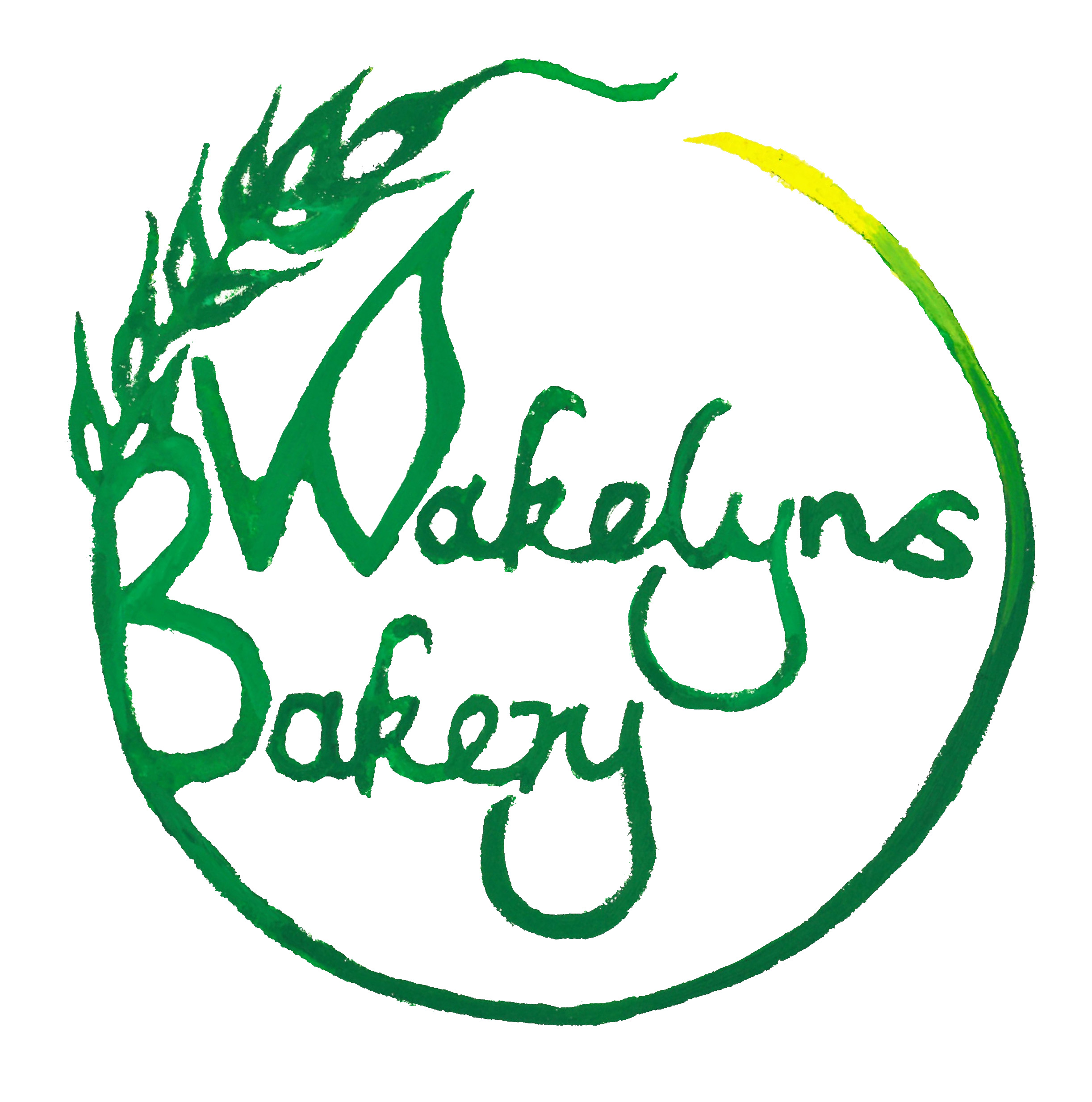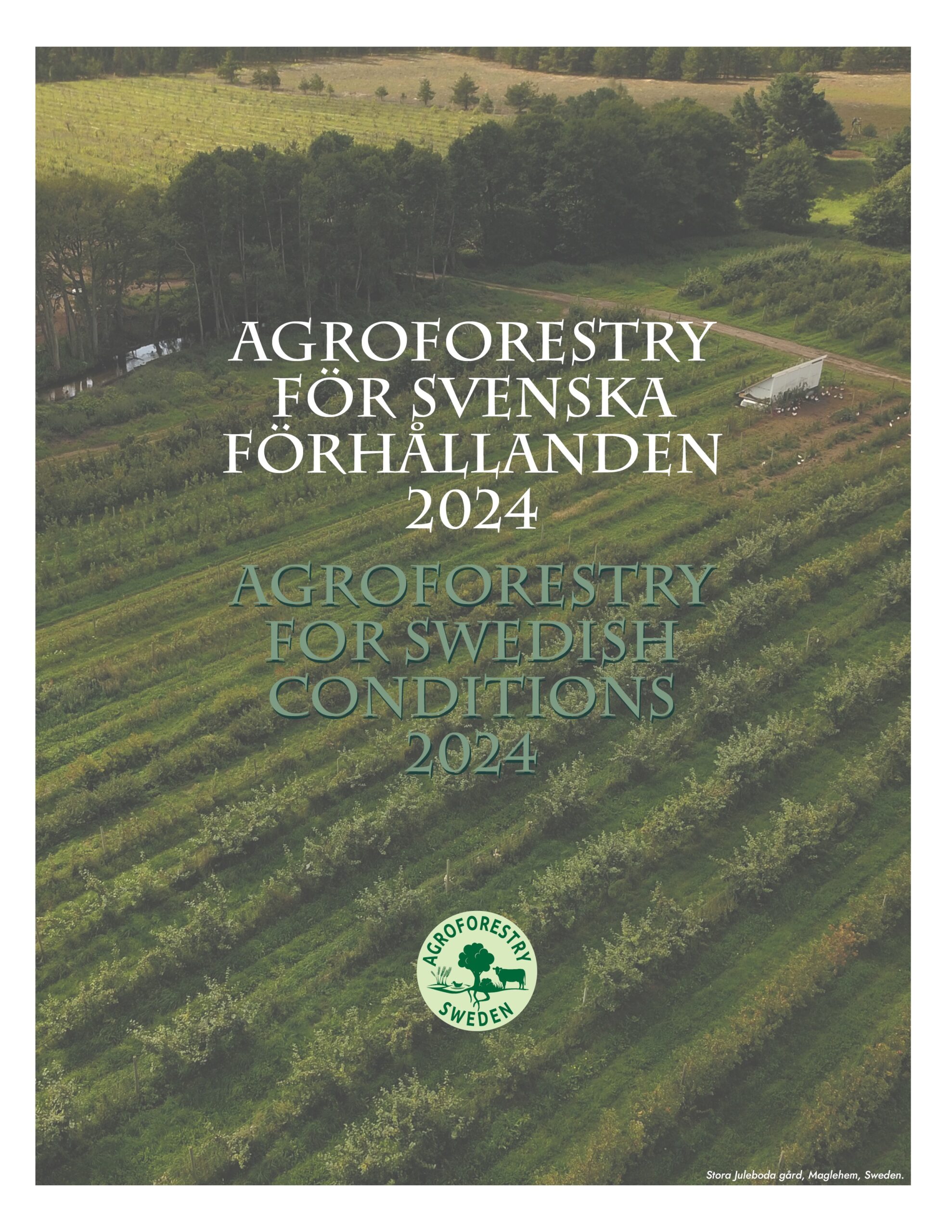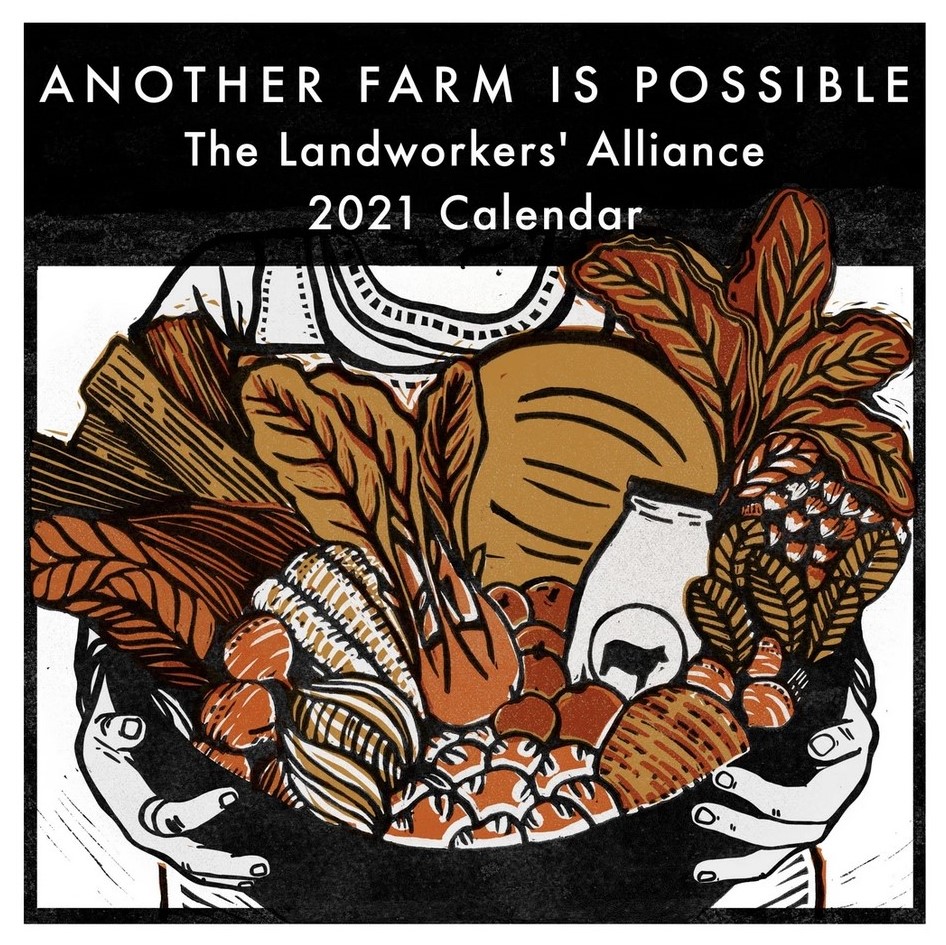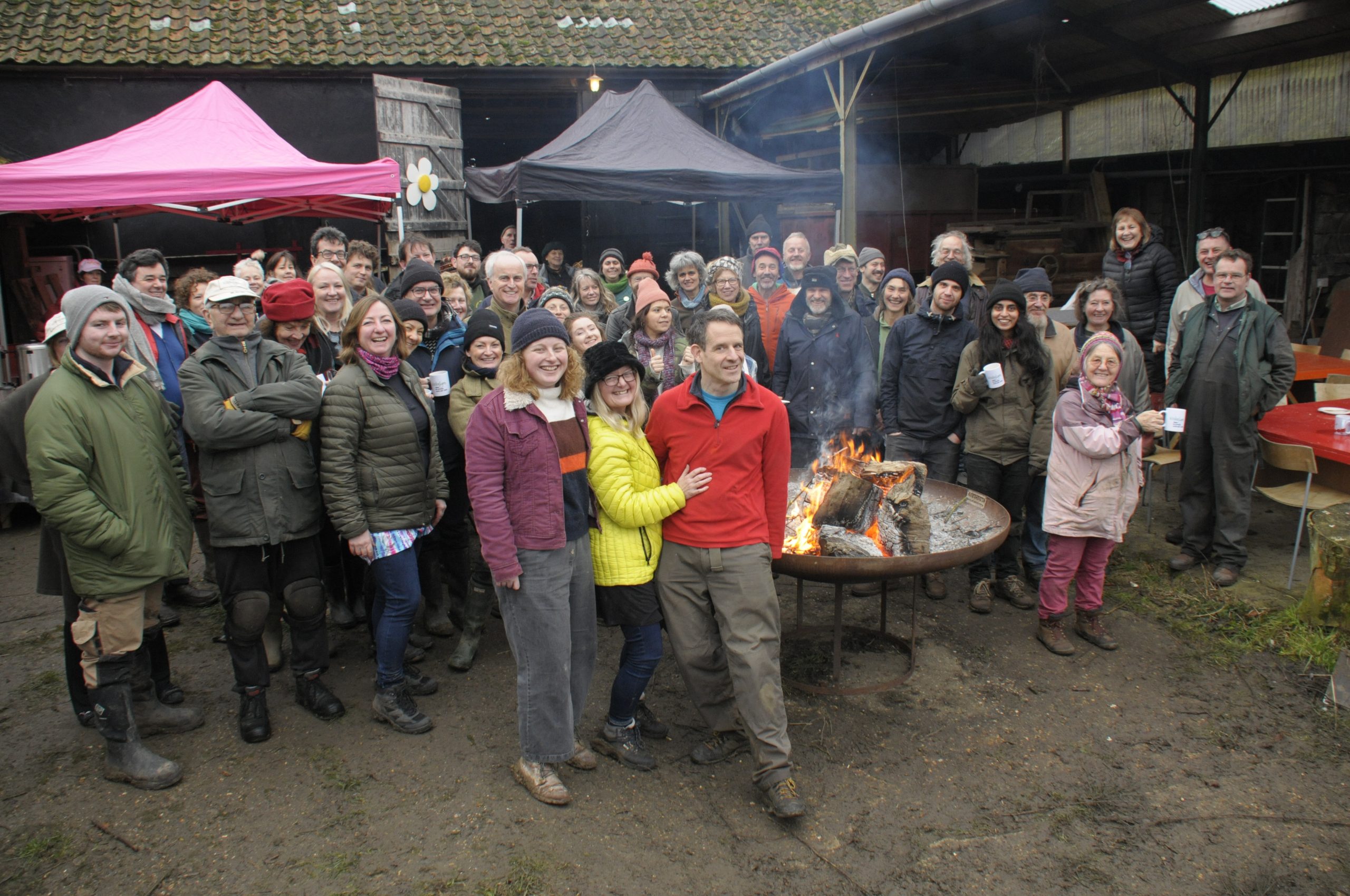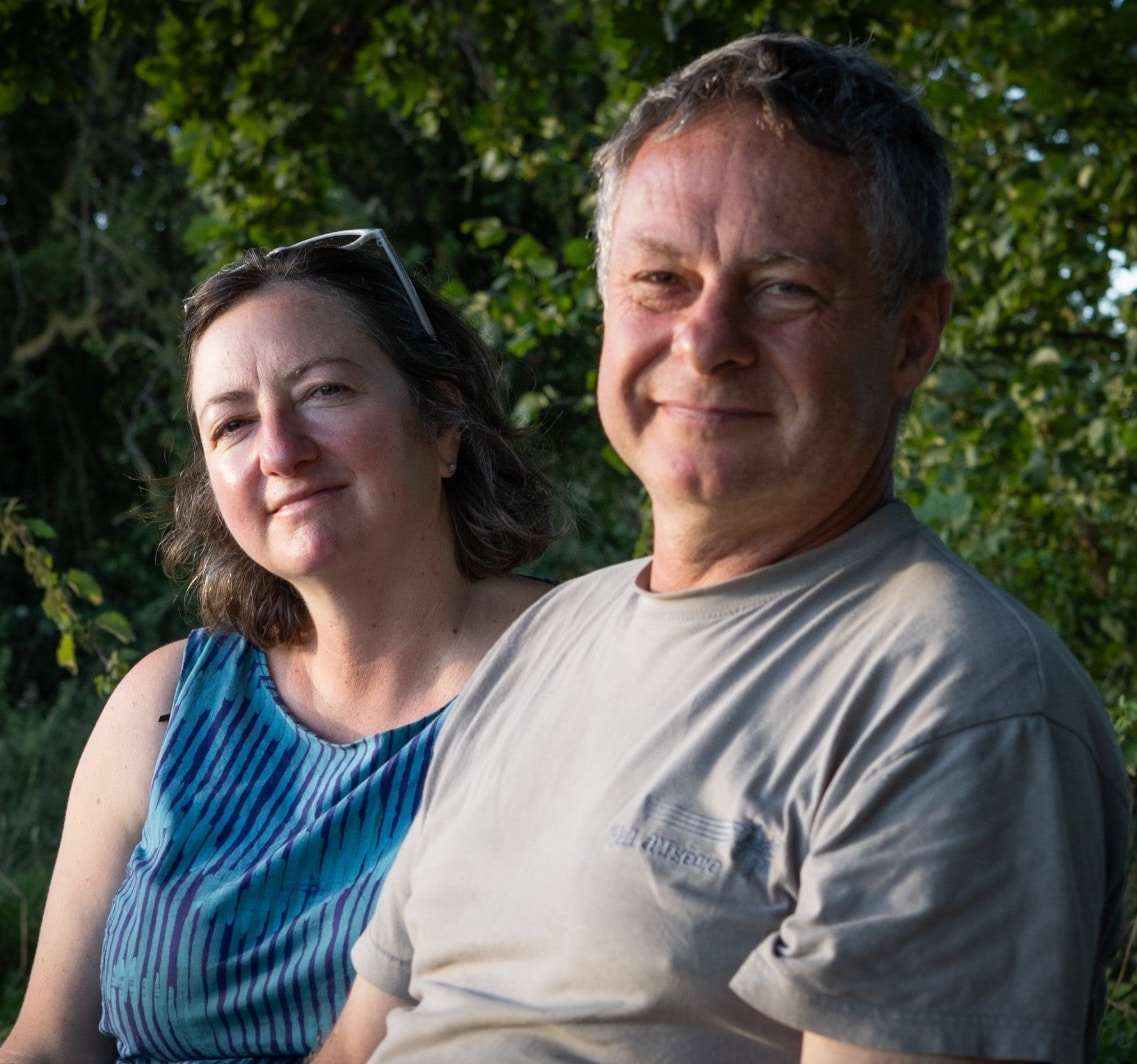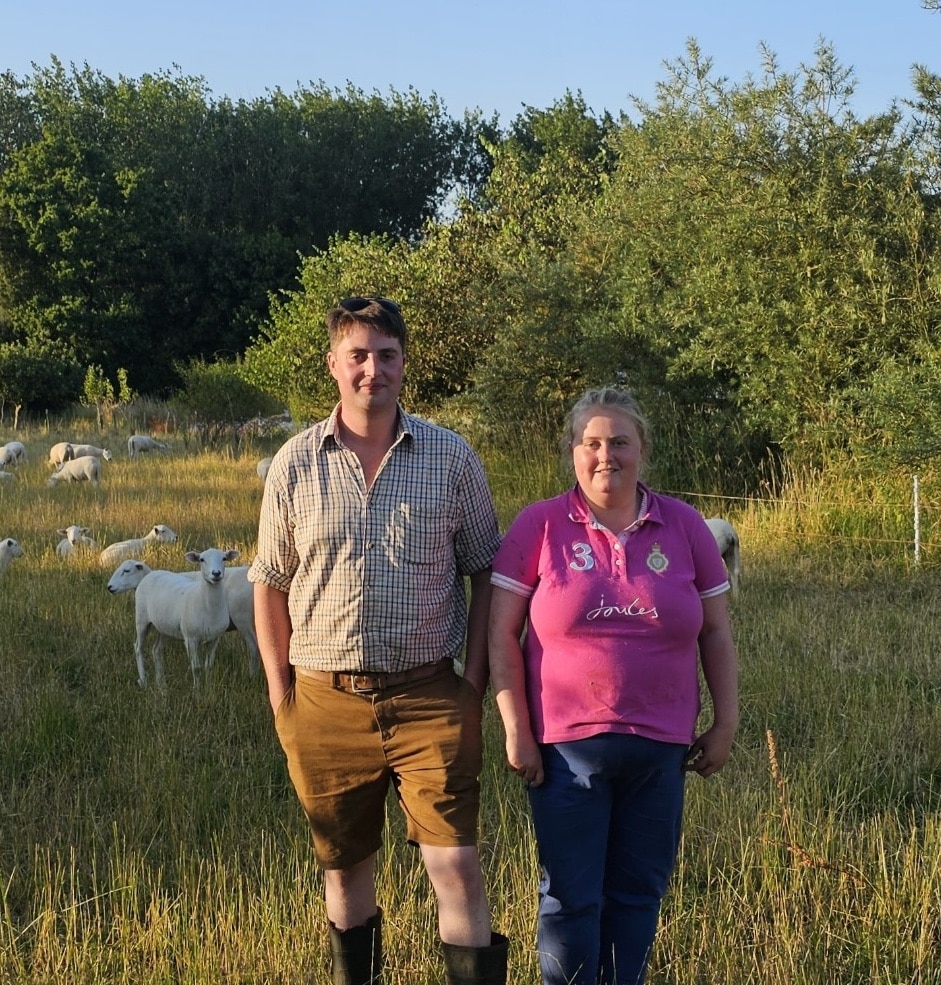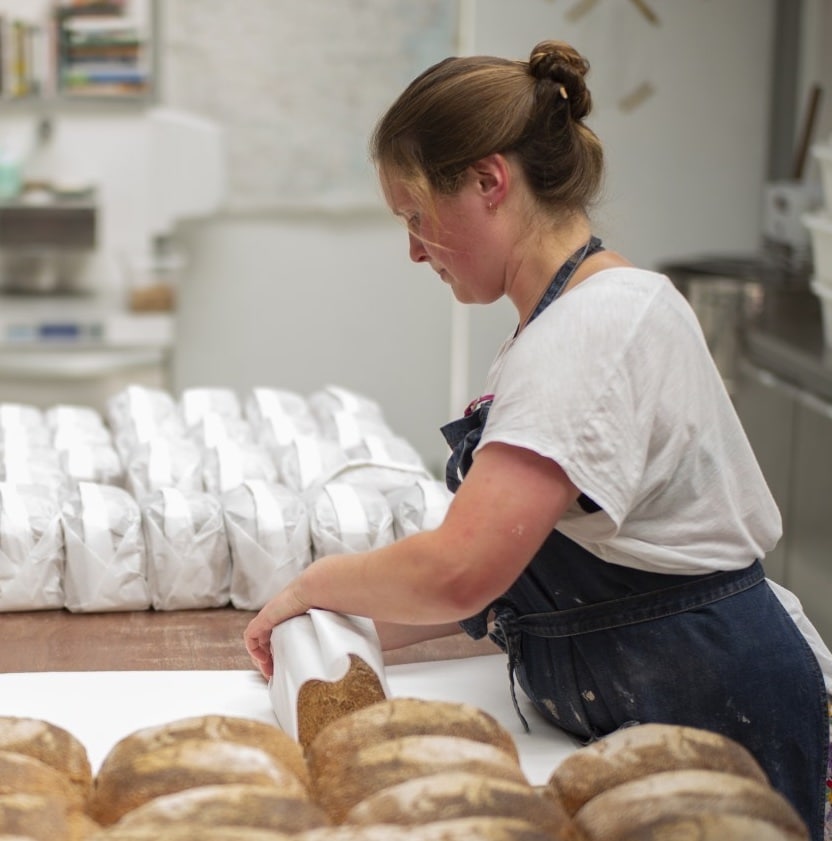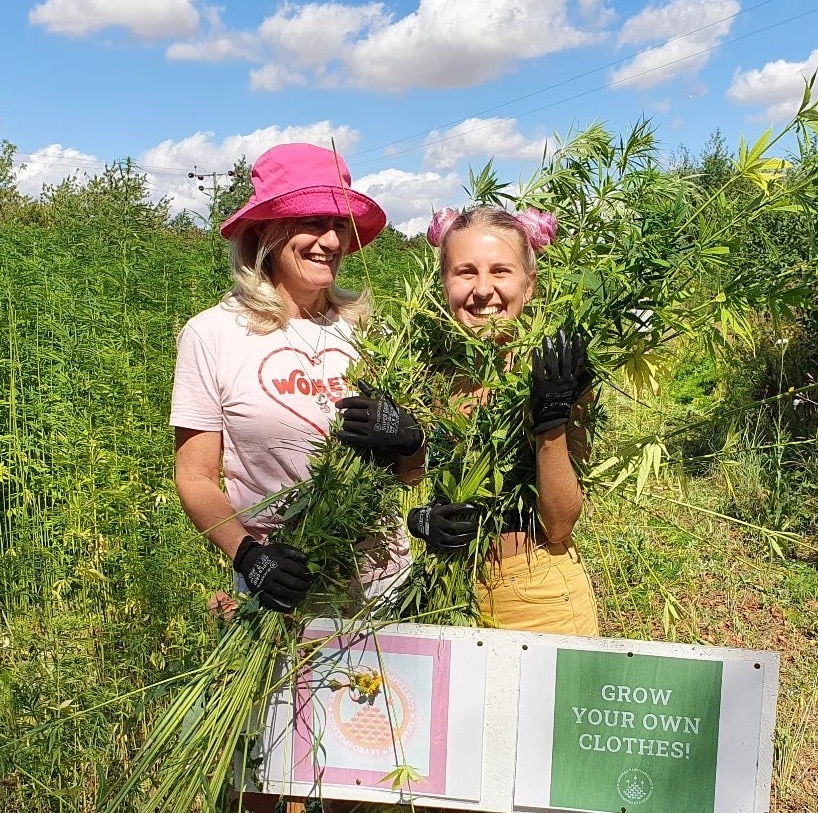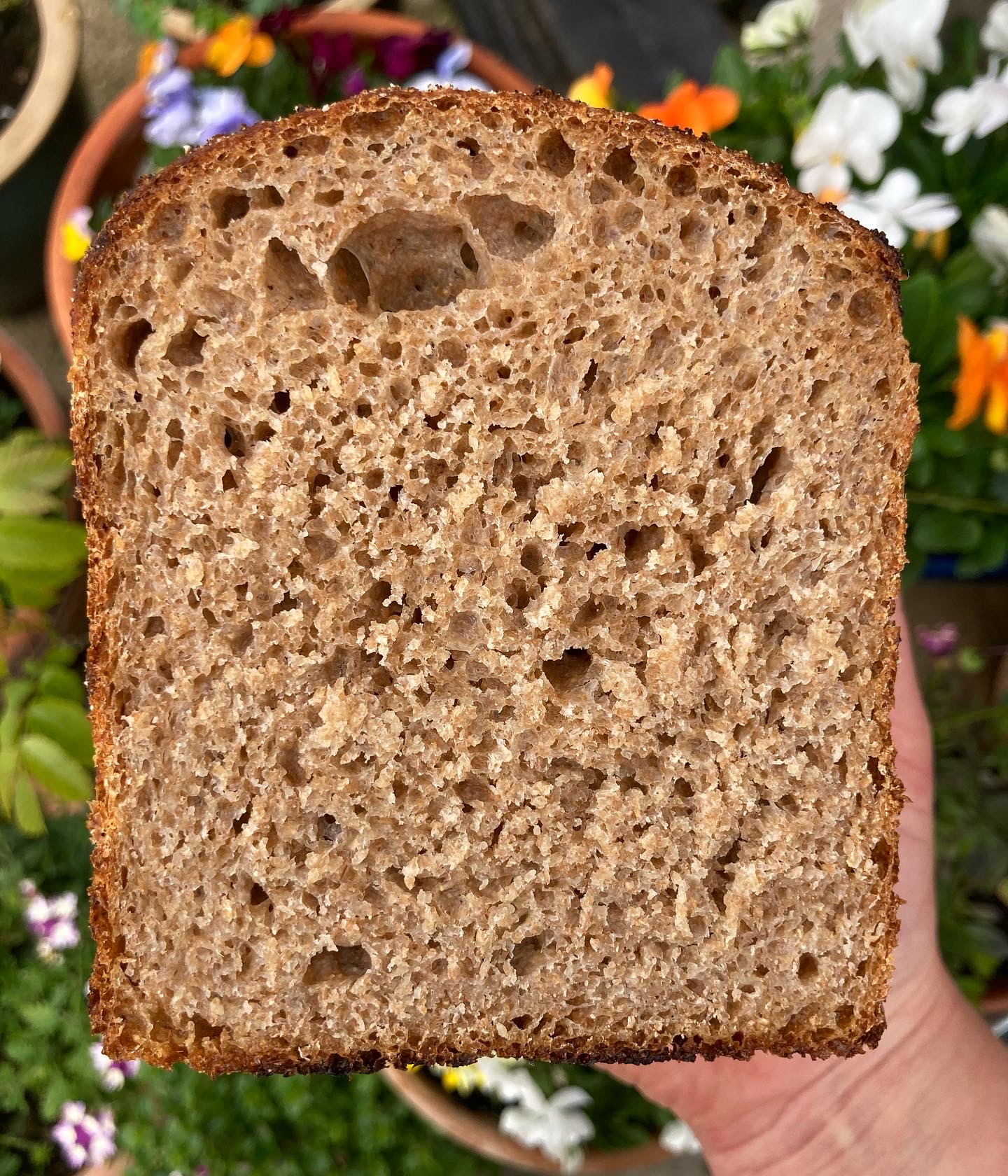
Thursday 17th February 2022 – Wholegrain ‘YQ’ ORC Wakelyns Population wheat sourdough tin loaf
As the second full moon of the year brightens the evening sky and the early morning, we’re getting into the swing of being back in the bakery after some rest for us both over Christmas and the new year. We’re feeling rejuvenated and full of energy and ideas as well. We are organising our courses and events and setting goals for the year. One of them is sharing more recipes with you, that we feel is of vital importance.
We know that food sovereignty and food justice are not only about everybody having access to food grown for human and planet health, but also knowing what that actually means (education), how and where to access that food (accessibility) and, once you have it, how to cook with it (back to, education = empowerment!). If we don’t have this knowledge and vital cooking-tool at our fingertips, how can we nourish ourselves, our friends, our families, and our Earth?
This year we hope to share as many recipes with you as we can, whilst at the same reminding you that these are just a guide. Do always remember that and in doing so, to adapt them to what you have growing around you and what your farmers are growing. As we share our recipes, we’ll try to give alternatives with regards to different grains, vegetables, fruits and more that you could use.
We strongly believe that a real loaf of bread, made with just wholegrain flour, salt and water, should be at the centre of every table, so the first recipe of the year that we wanted to share is our wholegrain YQ tin loaf.
The photos below show Maisie with the membrane, Rosie with the springy dough ball after mixing, our baked tin loaves from one of our last 2021 bakes, and pitta breads Maisie and Rosie made with some extra dough. It was really wonderful to have Rosie Wolfe in the bakery with us this week and last week, helping us lots, baking, sharing and eating with us. Thank you, Rosie!
Recipe for 1 900g YQ tin loaf
To build the starter –
75g Wakelyns YQ population wholegrain wheat flour
25g active starter
35g water at room temperature.
Mix all the ingredients together until well combined, cover and leave to ferment overnight, or for at least 10 hours. Please note that this is a stiff starter therefore it will look stiff! And quite dry. This is normal.
To make the dough –
335g water at 21oC, a little warmer if your house is cold, a little cooler if your house is warm (this is because the ideal dough temperature we want to achieve is about 21oC)
130g starter from above
425g Wakelyns YQ population wholegrain wheat flour
10g sea salt
MIX
In a large mixing bowl, combine all of the ingredients and mix using one hand until well combined. Carry on mixing for around 5 minutes until the mixture starts to feel springy or “doughy” as opposed to “cakey”.
KNEAD
Lightly dampen your work surface and turn the dough out on to it. Roll your shoulders back, stand with your feet shoulder width apart, and start to knead or add your energy to the dough. Depending on your method, you will need to do this for around 15 minutes. It may feel sticky to begin with, but keep going! Try not to add any extra flour or water. Over time it will start to become an elastic, silky and smooth dough. You can test the strength of the dough by checking to see if a “membrane” has formed when you gently stretch out a piece of the dough, as shown in the picture below –
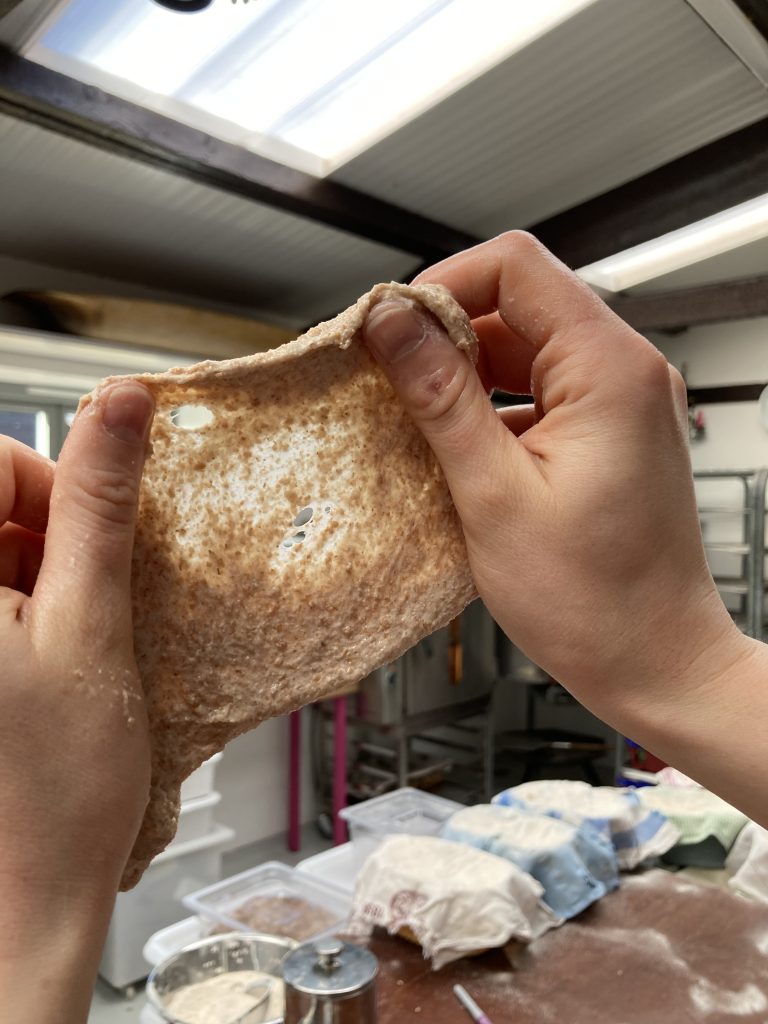
BULK PROVE/ BULK FERMENT
Check the temperature of the dough, it should be at around 21-22oC.
Lightly oil your mixing bowl, or splash it with a little water. Pull the dough across the work surface using a tucking motion and shape it into a round, with a slight smooth tension forming on the top of the dough. Place this, smooth side down, into your mixing bowl. Cover with a damp tea towl or a lid, and leave in a cool area, around 21oC, to bulk prove for 2 hours and 30 minutes.
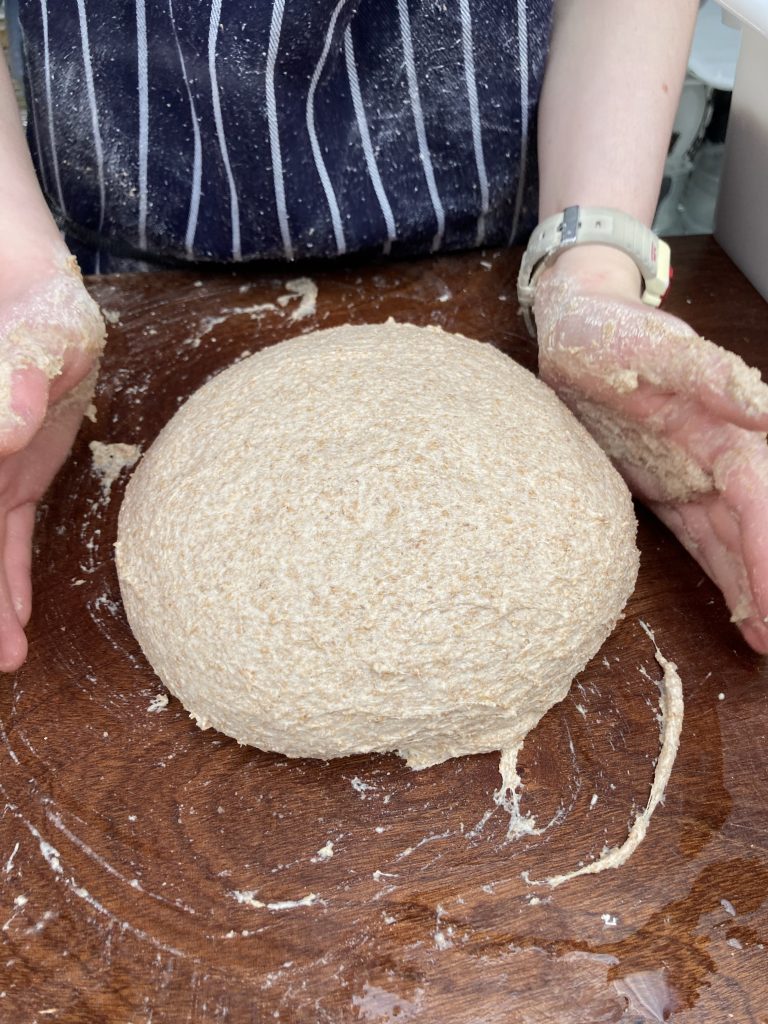
30 minutes into the bulk prove, give the dough a “stretch and fold”. With wet hands, gently lift one side of the dough and give it a light stretch, and fold it into the centre. Work your way around the dough stretching and folding until you get back to the beginning. 30 minutes later, repeat this process.
SHAPE AND INTO THE TIN
Grease a 1kg loaf tin – we use Mike Stringer’s organic rapseed oil from Hodmedod’s. As a guide, our tin is approx. 8.5cm deep x 10cm across/ width x 20cm long/ length (exterior measurements).
Your dough should now be ready to shape, or more like just put (!), into the tin. It is ready when, if you shake the bowl it is in, it has a good wobble, and when touched, it feels light and quite full of air. If you think it needs a little longer, let it hang out for a little longer!
Wet your hands and gently place them under the dough. Lift it up and place it straight into the tin, being gentle with the dough and not losing too much aeration. Try to ensure that the dough fits well into the shape of the tin, and the top is relatively smooth, but please don’t worry if this is not the case! Leave the tin somewhere warm-ish, but not boiling, for around 3 hours for its final prove. It may take more or less time depending on the room temperature. You may need to lightly splash/spray the top with water to prevent the crust from drying out. About 3 hours later, it should have risen to the top of the tin and be forming a concave shape, like seeing half of the sun when it is on the rise.
STENCIL AND BAKE
At this point, you can stencil the top of the ‘dough sun’ with anything you like – hold your hand over the dough and sift over the flour for your handshape; cut out a shape that means something to you or the person you are giving your loaf to… do this by spraying the top of the loaf with a little water and using a bit more wholegrain YQ flour and a sieve.
Bake at 230oC for 35 minutes or until a deep brown crust has formed; the loaf feels hollow or like a good drum-sound when you tap it on top; it comes out of the tin easily; and the centre of the loaf has reached 98oC. Patiently wait until it has fully cooled down before you slice it. Difficult… but worth it! If you are unable to do this, oh well! Yum yum! Find some butter!
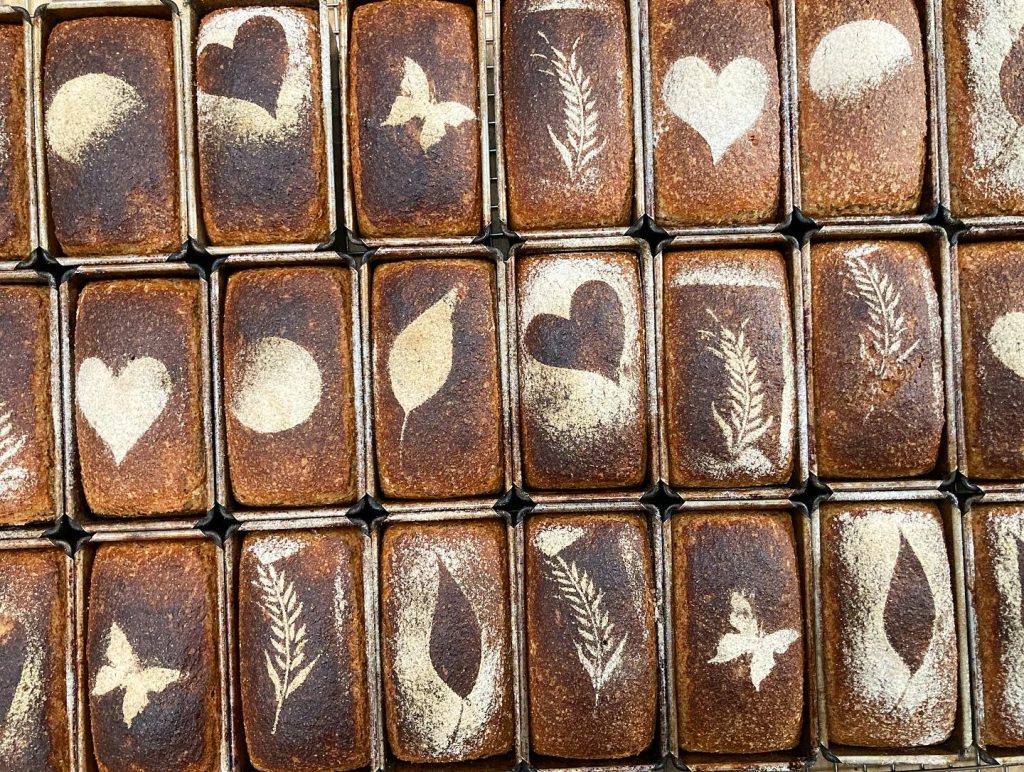
Notes
Other wholegrain flours – as well as sharing more recipes this year, we are baking with more grains. We will use this recipe/ formula, adapt it, and let you know the results with the other grains we use. In general, it works well with UK grown wheats – we tried it with Jeremy Dickin’s Flanders wheat from Hodmedod’s the other day and it was great – and heritage wheats. It is around 12% protein.
Bakers’ formula – if you bake regularly or work in a bakery, here is our formula for this loaf
% Final dough mix Weight (g)
% 100.00 flour, YQ WM 426.14
% 79.00 water, final 336.65
% 30.00 starter, YQ WM 127.84
% 2.20 sea salt 9.38
Inclusions
Once you have a wonderful wholegrain foundation dough base, the world is veritably your oyster! You can add nuts, dried fruit, seeds, potato or squash to make it a bit fluffier, fruit, butter-honey-eggs for brioche. Play around with it and see what works for you, what’s around you? Add these ‘inclusions’ just after the dough has been mixed and before the bulk prove. We love adding seeds to ours, so here are our seedy inclusions for a 1kg loaf –
The night before you mix, boil 200g water and add 100g to swell up with –
50g naked oats
35g flax seed
1tsp chia seed
1tsp coriander seed
1tsp camelina seed
1tsp fennel seed
Keep outside at room temperate. The next day, mix your dough using the above method and the following quantities – 380g flour, 300g water, 114g, starter, 9g salt
Prove, shape and bake as with the YQ tin loaf recipe
Other yummy things to make with your dough
After the bulk prove, instead of putting the dough into the tin, you can
cut off 100g dough, shape into a ball, roll out on a floured surface to a bit less than 1cm thick to make pitta breads, as below. Bake on the flour of an oven pre-heated to about 200oC, or cook in a dry pan. You can do flatbreads/ pizzas galore with the technique! Use a larger amount of dough to make pizza; roll a little thinner and spread with green sauce; oil, rosemary and thinly sliced potatoes… or you can also add a filling, wrap the dough up around it, pat it to secure, roll it out and make filled flatbreads, or parathas. Just remember, have fun, don’t have any expectations, go with the flow, smile and stay present with your dough; it’s alive, as all food is, as we are.


